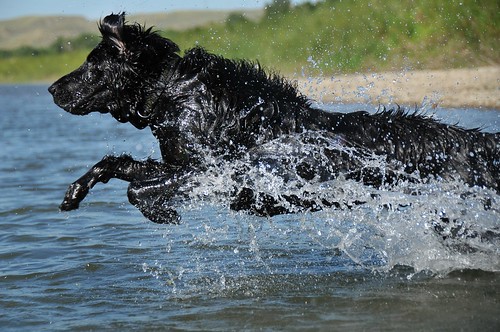

Performance (athletes) Dogs
Dogs have been an integral part of human culture for all of their history. As our culture has changed, the role of canines has evolved to fit our modern lifestyles. There are three basic groups of athletic dogs, recreational, competitive, and working. Recreational athletes are dogs that chase squirrels, dig holes, play race and chase with their friends, swim, play ball and Frisbee, and/or hike with their owners. Competitive athletes participate in events such as conformation, obedience, tracking, agility, lure coursing, and fly ball. Working dogs are involved in service work with people who have disabilities or medical conditions, do search and rescue, police work, and farm work such as herding. It is important for these active dogs to be kept well conditioned and fit. They are more prone to repetitive stress conditions and injuries. Proper massage can aid in muscular recovery after an active day, reduce fatigue and stress, and increase muscle tone. Massage can be used before sporting events or exercise to warm muscles and prevent injuries. It is also an important component in treatment of injuries.
Increased Muscle Tone
In the wild, dogs are constantly on the move, running, jumping, stretching and as a result are usually maintain good muscle tone. In our domesticated situations, they are usually confined to an indoor situation and develop many of the problems that we do from being sedentary. Inactive dogs are prone to premature aging, stress and anxiety, weight gain, poor muscle tone, and serious medical conditions. Regular massage can decrease the effects of an inactive lifestyle by loosing tight, constricted muscles and increasing range of motion in joints.
Provide Comfort to Muscles Injuries
There are times you’ll be called in on an existing case under veterinarian supervision or as part of the rehabilitation process following an orthopedic type problem or actual muscle injury. After the appropriate time for healing, you find massage, stretching, and the proper exercise can help the process along by encouraging the scar tissue to lie down in better pattern. Reducing any amount of scar tissue as it adheres to healthy tissue can help restore the muscle to better returning function.
Evaluation and Assessment Benefits
When we work with a dog on a regular, systematic basis with massage, we become familiar with all aspects of their bodies. Sometimes owners are not aware of changes that occurred in their dogs until they are very serious. Swellings, lumps, masses can be found and diagnosed early. Problems such as hip, shoulder, or knee dysfunctions can be recognized in their early stages and properly treated with veterinary care and rehabilitation. The development of sensitive touch can allow the dog to “tell” you when something isn’t right.
Increase the Range of Motion
A dog that moves better is more efficient in his stride. There is less wear and tear on the joints, ligaments and tendons equating to a longer performance life.
Socialization
Socialization is one of the most important aspects of raising a dog. It teaches them to feel comfortable with people, other animals, in new and different situations. It lays the foundation which allow them learn new behaviors, be calm and relaxed, and to interact with their environment. Massage can be a important component in a young dog’s socialization training and can serve as a therapeutic tool for dogs who have been abused or didn’t receive proper socialization.
Adjunct to Other Treatments
Massage can be used in conjunction with other therapies in a rehab situation. It can used to enhance post-operative recovery, as a catalyst from sickness, as an adjunct in cases of shock and severe debility. It is also effective in the reduction of anxiety – whether from storms, trips to the vets and groomers or to a boarding facility. It can be used with pets that are grieving from the loss of another animal companion or owner.
Assess the Physical Condition
It’s easy to feel tight muscles on a dog especially when it’s unilateral. Subtle changes in texture, temperature and tension can be detected with the hands. Often subclinical issues are hard to recognize, but earlier detection can mean permanent damage is lessened.
Communication
Massage is a very effective tool for communicating with dog. Because they communicate on a non-verbal way, massage is a very effective way to deepen the bond between humans and dogs.
Seniors
As dogs age, they are more prone to muscle soreness and joint problems. Regular massage increases flexibility, range of motion, and warms and soothes achy muscles. Massage also gives older dogs more quality time and tenderness.
Massage is used along with conventional and complementary health care as well as proper training techniques enabling the dog to perform at an optimum level. By itself, it does not attempt to cure anything.


6 comments:
Congrats, Sarah. Your hard work is paying off.
Wow! What an accomplishment! Congrats!
hurray ! Congratulations!!!
I will be setting up appts. for my boys :)
That is very interesting Sarah. Obviously a treatment from you will enhance many things for my dogs. Congrats for finishing your course!
Congratulations - I've been following your blog for awhile. I'd be interested in finding out what organization you trained with as this is something I have been looking into myself.
Congratulations!
your lucky dogs (both personal dogs and those who reap the enefits of your work!)
Post a Comment